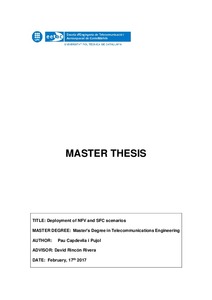Mostra el registre d'ítem simple
Deployment of NFV and SFC scenarios
| dc.contributor | Rincón Rivera, David |
| dc.contributor.author | Capdevila Pujol, Pau |
| dc.date.accessioned | 2017-03-02T16:16:32Z |
| dc.date.available | 2017-03-02T16:16:32Z |
| dc.date.issued | 2017-02-24 |
| dc.identifier.uri | http://hdl.handle.net/2117/101879 |
| dc.description | Aquest ítem conté el treball original, defensat públicament amb data de 24 de febrer de 2017, així com una versió millorada del mateix amb data de 28 de febrer de 2017. Els canvis introduïts a la segona versió són 1) correcció d'errades 2) procediment del darrer annex. |
| dc.description.abstract | Telecommunications services have been traditionally designed linking hardware devices and providing mechanisms so that they can interoperate. Those devices are usually specific to a single service and are based on proprietary technology. On the other hand, the current model works by defining standards and strict protocols to achieve high levels of quality and reliability which have defined the carrier-class provider environment. Provisioning new services represent challenges at different levels because inserting the required devices involve changes in the network topology. This leads to slow deployment times and increased operational costs. To overcome the current burdens network function installation and insertion processes into the current service topology needs to be streamlined to allow greater flexibility. The current service provider model has been disrupted by the over-the-top Internet content providers (Facebook, Netflix, etc.), with short product cycles and fast development pace of new services. The content provider irruption has meant a competition and stress over service providers' infrastructure and has forced telco companies to research new technologies to recover market share with flexible and revenue-generating services. Network Function Virtualization (NFV) and Service Function Chaining (SFC) are some of the initiatives led by the Communication Service Providers to regain the lost leadership. This project focuses on experimenting with some of these already available new technologies, which are expected to be the foundation of the new network paradigms (5G, IOT) and support new value-added services over cost-efficient telecommunication infrastructures. Specifically, SFC scenarios have been deployed with Open Platform for NFV (OPNFV), a Linux Foundation project. Some use cases of the NFV technology are demonstrated applied to teaching laboratories. Although the current implementation does not achieve a production degree of reliability, it provides a suitable environment for the development of new functional improvements and evaluation of the performance of virtualized network infrastructures. |
| dc.language.iso | eng |
| dc.publisher | Universitat Politècnica de Catalunya |
| dc.rights.uri | http://creativecommons.org/licenses/by-nc-sa/3.0/es/ |
| dc.subject | Àrees temàtiques de la UPC::Enginyeria de la telecomunicació |
| dc.subject.lcsh | Cloud computing |
| dc.subject.lcsh | Computer networks |
| dc.subject.lcsh | Optical communications |
| dc.subject.other | NFV |
| dc.subject.other | SFC |
| dc.subject.other | SDN |
| dc.subject.other | OpeNFV |
| dc.subject.other | OpenStack |
| dc.subject.other | Network Functions Virtualization |
| dc.subject.other | Service Function Chaining |
| dc.subject.other | Software Defined Networking |
| dc.title | Deployment of NFV and SFC scenarios |
| dc.type | Bachelor thesis |
| dc.subject.lemac | Telecomunicació -- Xarxes |
| dc.subject.lemac | Computació en núvol |
| dc.subject.lemac | Comunicacions òptiques |
| dc.subject.lemac | Ordinadors, Xarxes d' |
| dc.rights.access | Open Access |
| dc.date.updated | 2017-02-27T08:06:10Z |
| dc.audience.educationlevel | Estudis de primer/segon cicle |
| dc.audience.mediator | Escola d'Enginyeria de Telecomunicació i Aeroespacial de Castelldefels |
| dc.audience.degree | ENGINYERIA DE TELECOMUNICACIÓ (Pla 2001) |


